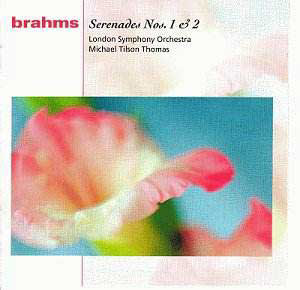Discs of these two youthful but important works are becoming
quite common. Such is their melodic appeal, their increasing stature in
the Brahms canon, and the convenience of fitting neatly onto a single
disc, that record companies are homing in on them. As with some of Mozartís
serenades, the title is somewhat misleading, and though there are many
sunny and light-hearted gestures in the pieces, a glance at the overall
timing tells the listener that these are weighty, large-scale works. Also,
this being Brahms, every ray of sun is balanced by darker shadows, and
these exceptional performances bring that Romantic dichotomy out perfectly.
Both Serenades are essentially dry runs for
Brahmsís foray into the daunting world of symphonic writing. Tilson
Thomas keeps things moving, and, more importantly, keeps a tight rein
on what can often emerge as unwieldy structures. This is especially
true of the D Major, which has no less than six movements. Whilst
it embraces music of an open, sunny nature and easy inspirational flow,
it underwent what the booklet calls Ďa cautionary gestation periodí.
It started out as a three-movement work, evolving into a large-scale
Nonet for wind and strings, before reaching its final form. The composer
wholeheartedly draws on his great forebears, particularly Beethoven
and Schubert, but one can easily detect an original voice emerging.
MTT has the London Symphony Orchestra phrasing elegantly, and draws
out appropriate parallels with the great Second Symphony to come.
This is especially marked in the long opening movement, where he observes
the important exposition repeat, revealing a wonderful Ďout-of-doorsí
feeling. By contrast, the mysterious half-lights of the D minor scherzo
which follows have one thinking way ahead to the melancholic older Brahms.
The finale has a dynamism inherited again from Haydn and Beethoven,
and Tilson Thomas pushes his band on to a glorious conclusion.
The Second Serenade, which had filled Clara Schumann
with such enthusiasm, gets an even finer reading. Although cast in a
five-movement structure, Brahms is beginning to show more mastery of
form, with compactness and integration being the watchwords here. MTT
adopts a beautifully flowing tempo, letting Brahmsís glorious melodies
unfold with complete naturalness. The LSOís wind players have a field
day in the scherzo, and rich, sonorous strings illuminate the
lively Rondo finale.
Make no mistake, these are richly satisfying readings,
recorded in splendid digital sound, though the booklet tells us nothing
of this. There are medium price and budget rivals, notably Haitink on
Philips, Francesco DíAvalos and the Philharmonia on ASV, and a highly
regarded IMP disc from Dirk Joeres and the West German Sinfonia. But
my inclination is to say that, irrespective of price, this disc is a
clear winner, and in its new super-budget format should not be missed.
Tony Haywood


